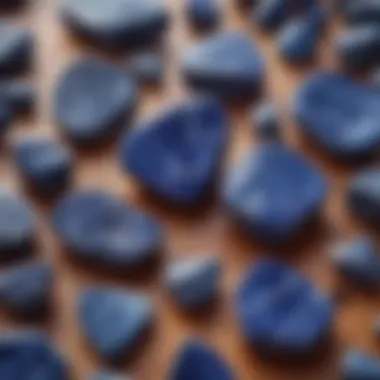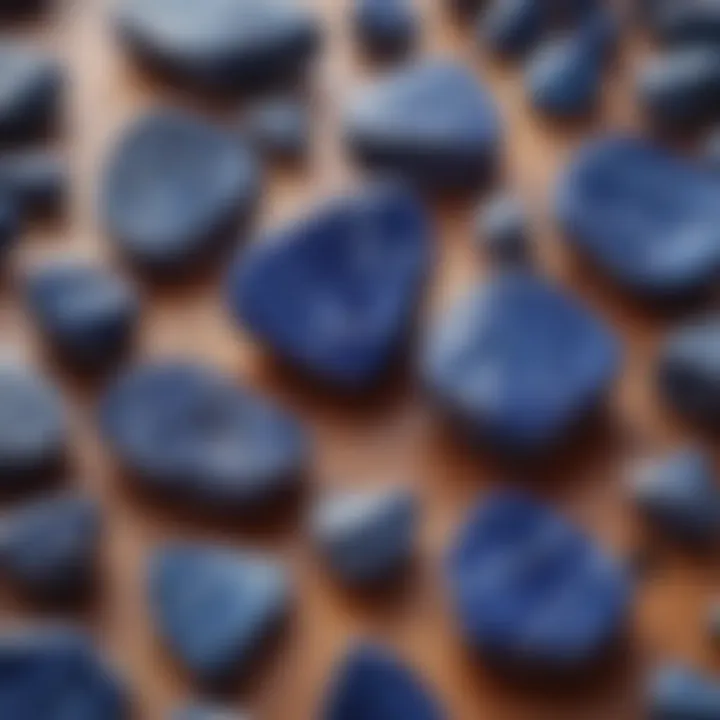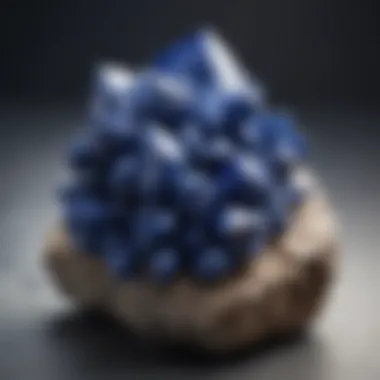Sodalite Stones: An In-Depth Exploration of Their Significance


Intro
Sodalite, a mineral cherished for its distinctive color and unique qualities, holds a special place in both rock collecting and the broader field of geology. Known primarily for its deep blue hues along with white veining, sodalite has captivated collectors and enthusiasts for generations. Its intriguing properties extend beyond aesthetics; it possesses an array of potential applications in fields like art, architecture, and even healing practices.
The upcoming sections aim to illuminate the multifaceted nature of sodalite, examining not only its physical characteristics but also its historical context and cultural relevance. Whether you are a seasoned collector, a newcomer, or simply someone who appreciates the beauty of minerals, this exploration will enhance your understanding and appreciation of sodalite stones.
Featured Collectible of the Month
Overview
Sodalite stones, characterized by their striking color combinations is particularly sought after in the collectible market. This mineral can be found in various localities, yet the finest specimens often hail from Canada, particularly from the province of Quebec. The vibrant hues and unique patterns make sodalite stones not only visually appealing but also a favorite among collectors.
"Sodalite is often mistaken for lapis lazuli due to its similar color, but its distinctive properties set it apart."
In recent months, sodalite stones have gained popularity in various communities, owing to their use in jewelry and decorative items. Their versatility extends to everyday objects such as coasters, tabletops, and figurines, contributing to sodalite's appeal.
Historical Significance
The history of sodalite dates back to the 19th century when it was first described scientifically. Historically, it has been associated with the chemical process occurring in the Earth's crust, leading to its formation from sodium-rich solutions. Over time, cultures recognized sodalite not just for its physical properties but also for its believed metaphysical benefits. It was thought to promote rational thought and illuminate one’s path to truth, making it significant in various spiritual practices.
Identification Techniques
Visual Characteristics
Identifying sodalite can be straightforward once one understands its key traits. Common visual characteristics include:
- Color: Deep blue with potential whitish, gray, or yellow veining
- Luster: Glassy to dull
- Hardness: Typically ranges between 5.5 to 6 on the Mohs scale, indicating it is relatively durable
- Transparency: Generally opaque; transparent specimens are rare
Resources for Identification
For those looking to deepen their knowledge about sodalite and enhance their collecting skills, several resources may prove helpful:
- Wikipedia: Sodalite Entry
- Britannica: Comprehensive articles on minerals and their significance
- Reddit: Joining relevant communities can provide insight and tips from fellow collectors
- Facebook: Groups focused on mineral collecting can serve as a platform for exchange of information and experiences
In summation, sodalite offers a rich narrative intertwined with geology, culture, and personal significance for many collectors. Its captivating presence in the mineral world not only appeals visually but also invites a deeper inquiry into its historical legacy and the practical knowledge surrounding its identification and care.
Prelims to Sodalite Stones
Sodalite stones have long captured the attention of collectors and enthusiasts alike. Their unique appearance and intriguing properties make them a vital subject for exploration in the realm of geology and mineralogy. Understanding the significance of sodalite involves examining varied aspects such as its physical properties, historical context, and usage in different fields.
The importance of sodalite in both scientific and cultural domains cannot be overstated. This article aims to highlight those aspects and offer insights valuable to both new and seasoned collectors. By delving into the particulars, readers can gain a deeper appreciation of this mineral and its place in the natural world.
Overview of Sodalite
Sodalite is a rich royal blue mineral, primarily composed of sodium, aluminum, and silicon. Its distinctive blue hue often contains white veining, making each piece uniquely appealing. This mineral was first recognized in the early 19th century and has since been associated with numerous attributes and uses.
Sodalite is not just aesthetically pleasing; it holds geological and metaphysical significance. From a geological standpoint, sodalite is classified as a tectosilicate mineral within the feldspathoid group. Its formation occurs in silica-deficient igneous rocks, predominantly in sodium-rich environments.
This mineral has practical applications, particularly in jewelry making and decoration of various items. It is often polished to enhance its gloss, making it a favorite among artisans and collectors. Beyond its physical attributes, sodalite stones have garnered a reputation in spiritual practices for promoting harmony and communication.
Often associated with the throat chakra, sodalite is believed to assist in better verbal self-expression and facilitate a calm state of mind. Its multifaceted nature makes sodalite a noteworthy subject for anyone interested in geology, culture, and even personal well-being.
"Sodalite is more than a mere decorative stone; it embodies a rich tapestry of history, geology, and metaphysical significance."
Physical and Chemical Properties
Understanding the physical and chemical properties of sodalite is essential for anyone interested in this intriguing mineral. These properties not only dictate the mineral's practical applications but also inform collectors about its origins, rarity, and overall value. Sodalite's unique characteristics contribute significantly to its desirability in both jewelry and for aesthetic displays.


Crystal Structure
Sodalite is classified as a tectosilicate, exhibiting a well-defined cubic crystal system. This cubic form presents an orderly arrangement of its atoms, often leading to well-formed dodecahedral and cubic shapes. The crystal lattice is primarily composed of sodium, aluminum, and silicate tetrahedra. This arrangement affects how light interacts with the mineral, producing its distinctive visual appeal.
The symmetry of the crystal system has implications for its cleavage properties as well. Sodalite tends to have perfect cleavage in three directions, contributing to its ability to be shaped for various applications, while also making it somewhat fragile in specific orientations. The crystal structure plays a critical role in the mineral's overall durability and usability.
Color Variations
Sodalite is most known for its rich blue color, which can range from deep navy to lighter shades. However, the presence of other minerals can result in a variety of colorations. For example, sodalite may contain veins or speckles of white, gray, or even yellow hues due to inclusions of calcite or other minerals. The intensity and consistency of color also can affect the stone's value.
The color diversity can be a geometric representation of its geologic origins. Locations where sodalite is found often contribute to these variations. For example, sodalite from Brazil may display different saturation than that found in Canada. Color plays an essential role for collectors and jewelers alike, as it often dictates the desirability and market price of the stone.
Hardness and Durability
In terms of hardness, sodalite ranks between 5.5 and 6 on the Mohs scale. This ranking signifies that while it is harder than some common minerals, it is still a somewhat soft stone, making it prone to scratches and wear if not cared for properly. This characteristic requires consideration when determining appropriate uses for sodalite.
Given its moderate hardness, sodalite is suitable for use in jewelry, particularly in pieces that will not experience excessive wear, such as pendants or earrings. However, collectors and users must take care to avoid exposing sodalite to harsh chemicals or abrasive surfaces.
Furthermore, the durability of sodalite can be impacted by its inclusions and overall quality. High-quality sodalite is often more resilient due to fewer internal flaws. Layers of protective coatings may enhance its physical properties, preserving its natural charm and integrity.
Sodalite's physical and chemical properties influence its appeal across various domains, from collectors to jewelers and metaphysical practitioners. Understanding these properties is essential for making informed decisions.
Historical Context of Sodalite
Understanding the historical context of sodalite stones is essential in appreciating their value and significance in both geological and cultural frameworks. Sodalite has been admired since its discovery and has played an influence in various regions throughout history. The narrative of sodalite is rich, showcasing its journey from the earth to various cultural artifacts, and enhancing the comprehension of its role in today’s society.
Discovery and Mining Locations
Sodalite was first identified in 1811 in Greenland by the German chemist and mineralogist, Heinrich Rose. It was mainly identified for its rich blue hue and unique consistency. The primary mining locations for sodalite are in Brazil, Canada, and Namibia, each offering unique varieties and quality. The Brazilian deposits are known for their deep blue color, often exhibiting stunning white calcite inclusions. Canadian deposits, particularly from Ontario, have also gained attention for their striking blue tones.
Mining practices vary significantly by location. In Brazil, the sodalite is mined in open-pit mines, while in Canada, the deposits are often located within larger rock formations which require more invasive extraction methods. This geological setting contributes to the unique characteristics and color variations of the stones sourced from each location.
In recent years, there has been a growing concern regarding sustainable practices in the mining of sodalite. Collectors and enthusiasts are urged to consider the origins of their stones, ensuring they support mining operations that prioritize both environmental and ethical standards. The historical significance of the stone is being coupled with modern ethical considerations, making the narrative of sodalite even more complex.
Cultural References Through Time
Sodalite has heralded various cultural references throughout history. In ancient times, it was thought to possess mystical properties, often linked to wisdom and communication. The stone was not only used for decorative purposes but was also considered a catalyst for instilling calmness and clarity of thought.
In different cultures, sodalite has been associated with various symbolic meanings. For example, some Native American tribes revered sodalite, linking it to healing practices and ceremonies. The belief in the stone’s capability to enhance intuition and enhance expression has persisted through the ages. Today, sodalite is often employed in spiritual practices. It is commonly used in meditation for fostering peace and reassurance during introspective moments.
The cultural references to sodalite are not limited to spirituality. In the artistic world, sodalite has been historically valued for its aesthetic appeal. Artists and craftspeople have utilized the stone in their works, embedding its blue pigments in various artistic forms, enriching both traditional and contemporary art.
"The journey of sodalite through history showcases its multifaceted nature, providing insights into both its geological formation and the cultural narratives that have elevated it through time."
Understanding the historical significance of sodalite stones enriches the experience of both collectors and those interested in the mineral. As we delve deeper into the stone's past, we unlock layers of meaning and appreciation that continue to resonate today.
Geological Significance
The geological significance of sodalite extends beyond its aesthetic appeal and into the realms of mineralogy and petrology. Understanding this mineral's formation and characteristics offers insight into the geological processes that shape our planet. Sodalite, primarily composed of sodium, aluminum, and silicate, is often found in alkaline igneous rocks, notably in syenites and phonolites. This places sodalite in the context of geological environments where unique conditions prevail, allowing for its development.
Sodalite's importance lies in its role as an indicator mineral, providing clues to the cooling and crystallization processes of magma. This mineral contributes to our understanding of how certain types of rocks form under varying temperatures and pressures. Studying sodalite-bearing rocks enables geologists to reconstruct ancient environments, enhancing our knowledge of the Earth’s history.
Benefits of Understanding Sodalite's Geological Significance:
- Insight into Rock Formation: Sodalite assists in explicating the formation of alkaline rocks, revealing the relationship between mineral content and environmental factors during crystallization.
- Resource Exploration: Mining and exploration companies value sodalite for its insights into potential mineral deposits in alkaline environments. Identifying regions rich in sodalite may lead to the discovery of other valuable resources.
- Educational Value: Sodalite serves as an excellent educational tool in geology. It provides students and enthusiasts hands-on experience in identifying and understanding igneous rock compositions.
In summary, the geological significance of sodalite encompasses not only its physical attributes but also its implications for broader geological studies, contributing to our understanding of Earth’s dynamic processes.


Formation Processes
Sodalite forms under specific geological conditions, which are essential to comprehend for those interested in its significance. The primary formation process of sodalite occurs in volcanic or plutonic environments where alkaline magmas cool and crystallize. These magmas are derived from the partial melting of continental crust, often influenced by subduction processes.
Sodalite’s crystallization happens at relatively high temperatures and low pressures, generally between 800°C and 900°C. Here's a brief overview of the formation process:
- Melting of Alkaline Rocks: The initial stage involves the melting of crustal rocks that are rich in alkali metals. The result is a magma that contains a high concentration of sodium and aluminum.
- Magma Evolution: As the magma rises, it may undergo differentiation, altering its chemical composition. This evolutionary process can lead to various mineral assemblages, including sodalite.
- Crystallization: When the temperature decreases, sodalite begins to crystallize out of the melt. Its formation can also result from the alteration of other minerals, such as feldspar, under specific conditions.
These processes are significant in understanding the nature of sodalite and where it can be found. Exploring the geological significance of sodalite provides not only insight into the mineral itself but also the intricate processes that shape our world.
Uses of Sodalite Stones
Sodalite stones demonstrate remarkable versatility owing to their unique properties. This section underscores their significance in both ornamental and industrial fields. Understanding these applications can provide insight into why sodalite is favored by enthusiasts and professionals alike, revealing the mineral's role in aesthetics, functionality, and its broader implications in various industries.
In Jewelry Making
Sodalite is cherished in the world of jewelry for its striking blue hues, often flecked with white calcite. This creates a visually stunning stone that can enhance various jewelry designs. Artisans use sodalite in pendants, bracelets, earrings, and rings. By incorporating sodalite, jewelers not only achieve beauty but also add uniqueness to their creations.
One notable aspect is the relative affordability of sodalite compared to other gemstones. This allows even budget-conscious consumers to access quality pieces. Popular amongst designers are beads made from sodalite, which lend themselves to creative and personalized designs. Notably, some people believe sodalite aids in communication and emotional balance, adding an intangible value to jewelry made from this stone.
Key Benefits of Using Sodalite in Jewelry:
- Aesthetic Appeal: Its deep blue color stands out and complements various skin tones.
- Affordability: Cost-effective compared to other gemstones.
- Versatility: Suitable for various types of jewelry.
- Symbolic Properties: Holds significance in emotional and communication enhancement.
Industrial Applications
Beyond its allure in the jewelry sector, sodalite finds utility in several industries. Its hardness and durability make it advantageous for applications in construction and decoration. Sodalite can be processed into tiles, countertops, and even artistic sculptures. These products are valued for their durability and aesthetics, contributing to both interior and exterior designs.
Moreover, sodalite possesses interesting chemical properties. Some industries utilize it in producing certain types of glass and ceramics, where specific characteristics like color and strength are required. In recent years, there has been growing interest in sodalite for use in technological applications, particularly in components requiring reliable physical stability.
Industrial Uses of Sodalite:
- Construction: Utilized in decorative stones and building materials.
- Ceramics: Employed in the manufacture of ceramics and glass products due to its stabilizing properties.
- Artistic Medium: Sodalite sculptures and art pieces are created for aesthetic purposes.
"Sodalite's applications extend far beyond mere aesthetics, lending itself to practicality across various industrial sectors."
Understanding the multifaceted benefits of sodalite not only enriches appreciation for the stone but also enhances knowledge pertinent to rock and fossil collectors. The mineral’s journey from earthy origin to artistic luxury is a testament to its wide-ranging significance.
Sodalite in Spiritual Practices
Sodalite stones have long been regarded not just for their striking appearance, but also for their spiritual significance. In various cultures, these stones are believed to hold unique properties that can influence both mental and spiritual well-being. Understanding the metaphysical benefits of sodalite and its application in healing practices offers a greater appreciation for this mineral.
Metaphysical Properties
Sodalite is often associated with the throat chakra, which governs communication and self-expression. It is thought to enhance one's truthfulness, facilitating clearer articulation of thoughts and emotions. By fostering confidence in speaking, sodalite is a valuable tool for those engaged in any form of public speaking or spiritual counseling.
Moreover, sodalite is linked to enhancing intuition and aiding in the emotional balance. A practitioner might use sodalite during meditation to deepen focus and achieve clarity. It is believed that this mineral can help to dispel negative thoughts, promote peace, and encourage rational decision-making. For those interested in emotional healing, sodalite serves as a reminder of the importance of honesty—not only with others but also with oneself.
Healing Modalities
Sodalite is utilized in various healing modalities, including crystal healing, meditation, and energy work. Healers often recommend placing sodalite stones in spaces where meditation takes place, as their calming presence can be instrumental in achieving a peaceful environment. It can also be carried or worn as jewelry, providing a continual source of support.
"Sodalite is not only a tool for self-reflection but also a catalyst for personal growth."
In more structured healing practices, sodalite might be used during Reiki sessions or chakra balancing exercises. Its calming energy can help stabilize mental overload, allowing clients to process emotions more effectively. Additionally, crystal grids that incorporate sodalite are often designed to enhance communication, understanding, and healing among groups, making it popular in workshops or retreat settings.
In summary, sodalite is valued for both its aesthetic qualities and its spiritual significance. For those exploring their own spirituality or seeking emotional healing, the use of sodalite stones can be a meaningful part of their journey.


Collecting Sodalite Stones
Collecting sodalite stones is an enriching pursuit for enthusiasts. Sodalite is not just another mineral; it has unique properties, colors, and historical significance that pique the interest of rock and mineral collectors. Collecting these stones offers benefits such as aesthetic pleasure, educational opportunities, and potential investment value.
Identifying Genuine Sodalite
When collecting sodalite, it is crucial to identify genuine specimens. One of the most distinctive features of sodium-rich sodalite is its deep blue color, often interspersed with white calcite or gray spots, which creates an eye-catching appearance. To determine authenticity:
- Examine Color: Genuine sodalite exhibits a rich blue hue. Lighter or faded colors may indicate a lesser grade or imitation.
- Feel the Texture: Real sodalite has a smooth, waxy surface. If the texture feels too rough or different, it may not be authentic.
- Weight Matters: True sodalite is relatively hefty for its size due to its mineral composition. A piece that feels light might not be genuine.
Using a simple handheld magnifying glass can aid in checking for bubbles or irregularities, signs of synthetic stones.
Buying Tips and Resources
Acquiring quality sodalite stones requires careful consideration and research. Here are several tips for effective purchasing:
- Purchase from Reputable Dealers: Always buy from established sellers. Online marketplaces, local gem shows, and specialty shops are ideal.
- Ask for Certifications: Some retailers provide certification of authenticity for higher-end pieces. This documentation can assure you of the stone's quality.
- Join Collector Communities: Engaging with platforms like Reddit or Facebook enables you to connect with seasoned collectors for recommendations on where to buy.
- Don’t Rush: Take your time to compare prices. Some sellers may price stones higher due to demand or rarity.
Storing and Displaying
Correct storage and display of sodalite specimens are vital for preserving their quality. Here are practical tips for collectors:
- Avoid Direct Sunlight: Prolonged exposure to sunlight can fade the colors of sodalite over time.
- Use Soft Cloths: When storing or handling your stones, always use soft cloths to prevent scratches.
- Display with Care: Using glass display cases can enhance visibility while protecting the stones from dust and damage.
- Keep Moisture Controlled: Avoid humidity, as it can affect the integrity of the stone.
Maintaining the condition of your sodalite collection enhances its aesthetic appeal and ensures long-term enjoyment.
Sodalite Care and Preservation
Caring for sodalite stones is crucial for both preserving their physical beauty and maintaining their value for collectors. Proper care ensures that these unique minerals can be enjoyed for years to come. Sodalite, with its striking blue color and white veining, is not only aesthetically pleasing but also holds significance for many collectors and enthusiasts. These practices contribute to the longevity and overall condition of the stones, making them worthy of investment and admiration.
Cleaning Techniques
Cleaning sodalite stones requires a gentle approach to avoid damaging the mineral's surface. Here are essential cleaning techniques to consider:
- Water and Mild Soap: Use lukewarm water mixed with a few drops of mild soap. Soak the stone briefly and gently scrub it with a soft cloth.
- Avoid Harsh Chemicals: Do not use bleach or strong detergents, as these can cause discoloration or damage to the sodalite's surface.
- Soft Brush: For intricate patterns or hard-to-reach areas, a soft-bristled toothbrush can be useful. However, be gentle to prevent scratches.
- Drying: After cleaning, pat the stone dry with a soft towel. Avoid direct sunlight when drying, as this may lead to fading of color.
- Storage: When not on display, store sodalite in a soft pouch or a padded box to protect it from scratches and environmental factors.
Remember: Regular cleaning can enhance the vibrancy of sodalite stones while maintaining their quality. It is advisable to clean more frequently if the stone is in contact with oils from the skin or environmental pollutants.
Overall, effective care and preservation of sodalite stones underscore their significance to collectors. By employing appropriate cleaning techniques, enthusiasts ensure these beautiful minerals remain a valued part of their collections.
Closure
Understanding the significance of sodalite stones encompasses various aspects, crucial for both enthusiasts and collectors. This article highlights sodalite's unique properties and historical importance, making it evident why it holds appeal. The physical characteristics, such as its striking blue color and stability, contribute to its use not only in jewelry but also in industrial applications. Each of these elements plays a role in why collectors admire this mineral.
Summary of Sodalite's Importance
Sodalite has long captured the interest of mineralogists and collectors alike due to its distinct features. Here are some key points to consider:
- Aesthetic Value: The rich blue hue of sodalite, often streaked with white or gray, makes it visually appealing for decorative purposes.
- Geological Interest: Understanding how sodalite forms within the Earth’s crust provides insight into geological processes and the environments that create this mineral.
- Cultural Context: Sodalite’s usage in various civilizations over time showcases its importance beyond mere aesthetics—it reflects historical connections.
- Metaphysical Properties: Many believe in the healing and protective attributes attributed to sodalite, adding to its allure in spiritual practices.
In summary, sodalite is not a mere stone; it is a symbol of both beauty and history. For rock and fossil collectors, engaging with sodalite means appreciating both its scientific background and cultural significance. This duality enhances the collecting experience, making it a worthwhile addition to any collection.
Further Reading and Resources
In an ever-evolving field like geology, resources for expanding knowledge are vital. This section provides recommended materials that will enhance understanding of sodalite stones and their significance. Reading about related subjects helps to build a well-rounded perspective on mineralogy and its applications.
Whether a beginner or an experienced collector, the importance of continuous education cannot be overstated. Knowledge not only enhances appreciation for the material but also informs best practices in collection and conservation.
"The more you know about the rocks and minerals around you, the richer your collecting experience will be."
Books on Geology and Stones
Books provide a foundational base for understanding geology and minerals, particularly sodalite. Several categories of books can be explored:
- Textbooks: These often cover the fundamentals of mineralogy, including the properties and classifications of stones. Consider titles like "Introduction to Mineralogy" for a comprehensive overview.
- Field Guides: Look for guides that specialize in regional geology. They usually identify common stones, including sodalite, and can be handy in the field.
- Historical References: Books that delve into the history of gemology can provide insight into how stones like sodalite have impacted cultures over time. Titles such as "Gemstones: A Natural History" provide context around the uses and values of stones.
- Collectors’ Manuals: These books often contain practical advice on identifying, purchasing, and preserving stones. A manual aimed specifically at collectors can be invaluable for those looking to build a refined collection.
- Online Resources: Websites like Wikipedia and Britannica hold curated information on sodalite and similar minerals. They are excellent for quick facts and recent developments in geology.



